Converting APK to Flutter code is a complicated but useful process since it enables you to utilize the cross-platform features Flutter offers, without losing any functionality within your app. With mobile apps being used more frequently in businesses and personal settings, developers always look forward to their development processes. Indeed, Flutter is a very powerful platform with a single code base that can be used for applications both on Android and iOS devices.
In this blog, we will see the steps you can take to manually convert your Android APK file into Flutter code so that you can recreate it in a cross-platform manner that will work on Android, iOS, and even the web. But before we begin, let’s first take a little look at what an APK is and then also cover the basics of Flutter, after which we shall briefly discuss why you might want to do this conversion. Finally, we’ll walk through the step-by-step process of decompiling an APK and re-writing the app with Flutter.
app to increase your reach? Scale your business with innovative Flutter applications.
Delivered by a team of 150+ experts
serving clients in 20+ countries.
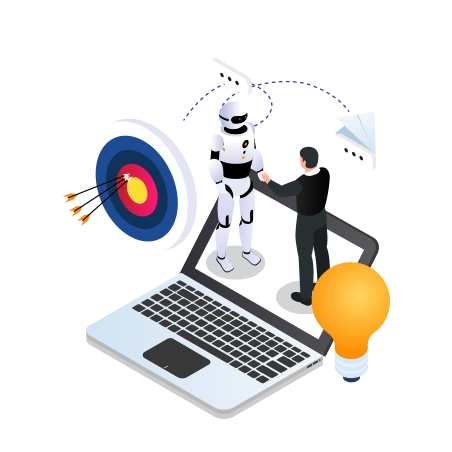
It’s particularly useful for a developer who has an existing Android app that would want to extend its reach with minimal maintenance over separate codebases on each platform.
What is an APK?
APK represents a file format in Android, which denotes how the system will be offering or installing applications. As with the executable file format at Windows, .exe, an APK file contains all of the elements that an application will need to run on an Android including compiled code, resources, such as images and audio, and the manifest file. APK files are mostly downloaded from the Google Play Store or third-party sites; most of them are installed manually on Android. The APK file is essentially a packaged application version that can be distributed and deployed for users.
What is Flutter?
Flutter is a free and open-source UI software development kit. It was developed by Google to help developers create natively compiled applications for mobile (iOS and Android), web, and desktop from a single codebase. It uses the Dart programming language and provides an amazing set of pre-designed widgets to create beautiful, responsive user interfaces. Another important feature of Flutter is “hot reload,” where developers can see the actual changes made in the code. The reason why Flutter attracts so many developers is because it can develop cross-platform apps with the same performance and UI across all platforms.
Why Convert an APK to Flutter Code?
Converting your APK to Flutter will save you time and effort as you only have one codebase to maintain all across the different platforms. It also saves you a lot of development time and benefits you from the fantastic ready-to-use UI widgets offered by Flutter. Moreover, after converting your APK, your app will be available on other platforms like iOS and the web.
Steps to Convert APK to Flutter Code
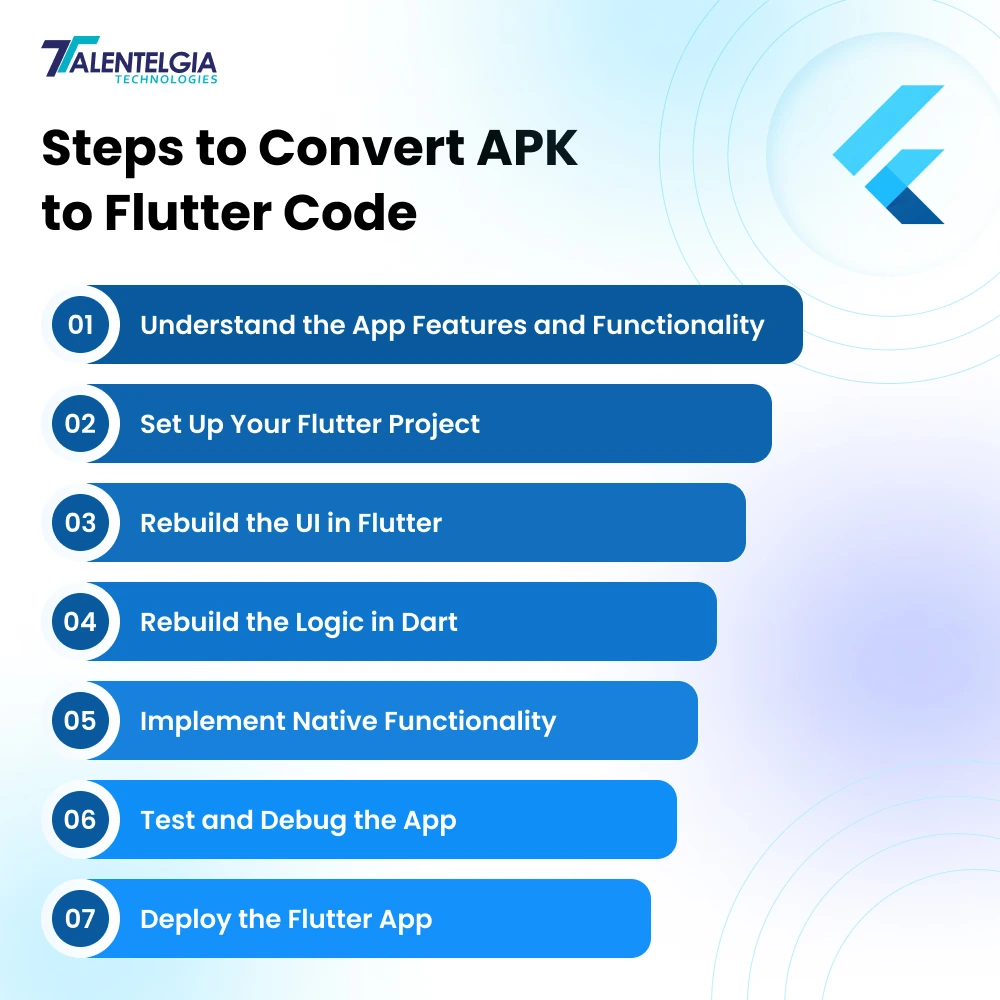
1. Find out the App Features and Functionality
- Decompilation of APK: Now, you may use a set of tools like JADX or APKTool to decompile the APK, from where you can obtain all kinds of resources like XML layout files, images, and in some cases, human-readable Java or Kotlin code.
- JADX: Actually, this will convert your APK’s DEX files back into human-readable Java code.
- APKTool: Useful for resource extraction, such as layouts and configurations, which let you understand the interface of the app.
- Examine the decompressed artifacts: This approach involves carefully going through the decompressed code along with the extracted resources, and understanding how the app has been built; this includes features, user interfaces, API interactions, and the general architecture.
- Extract resources: Download or copy all assets, images, fonts, and XML files from the decompiled APK. You will use these to remake the UI in Flutter.
2. Preparing Your Flutter Project
- Install Flutter SDK: Just before you start, ensure the Flutter SDK is correctly installed and configured for you to use. See the installation on the Flutter official website.
- Create a new Flutter project: Use the Flutter command-line tool to create a new project:
bash:
flutter create my_app- Project structure: Dart files should reside within lib/, images, and other assets in assets/. Store the resources you extracted from the APK into the appropriate directories.
3. Rebuild the UI in Flutter
& user-centric web applications with Flutter. Transform your ideas into reality with
cutting-edge Flutter applications.
Delivered by 150+ experts serving
clients in 20+ countries.

- Convert layouts to Flutter widgets: Instead of using XML-based layouts in the APK-like TextView, LinearLayout-rewrite with Flutter widgets-text, Column, Container.
For example:
XML:
<LinearLayout
android:orientation="vertical">
<TextView
android:text="Hello World"/>
</LinearLayout>is equivalent to:
dart:
Column(
children: [
Text('Hello World'),
],
);- Map navigation and routing: If your app contains more than one screen you’ll probably need to use Flutter’s Navigator and Route to manage page transitions:
dart:
Navigator.push(
Context,
MaterialPageRoute(builder: (context) => SecondScreen()),
);4. Rebuild the Logic in Dart
- Translate the business logic: Go through the decompiled Java or Kotlin code and then translate the app’s business logic into Dart. Since the syntax is similar to Java, you can port control structures, variables, and logic directly into Dart.
- Handle API calls: If the original app made HTTP requests, it can be easily translated into Flutter using libraries like http or dio. Example in Dart:
final response = await http.get(Uri.parse('https://api.example.com/data'));
if (response.statusCode == 200) {
// Process the JSON response
}5. Implement Native Functionality (If Any)
Platform-specific functionalities: If your APK uses native Android features such as camera, GPS, and notifications, you will be applying those using platform channels or Flutter plugins. For instance, if the APK uses the camera, you would be using Flutter’s camera package in this case.
Moreover, you can develop platform-specific code based on native Android capabilities further exploitable using Flutter’s method channel.
6. Testing and Debugging of the App
- Test the app: After rewriting the app into Flutter, thoroughly test it on Android. And, if that is not feasible, iOS devices to make sure that everything works as expected.
- Debugging with Flutter tools: Powerful debugging tools like Hot Reload, DevTools, and the command-line debugger via Flutter could be used to solve bugs. One can test its features, UI layouts, and performance to ensure that the app is working as intended.
7. Deploy the Flutter App
- Build the APK: After testing, you will need to create an APK for Android by executing the following:
bash:
flutter build apk- Build for iOS(if necessary): You can also build the app for iOS by running:
bash:
flutter build iosThis is how you would finalize the steps for manually converting an APK into Flutter code. The output of this process should be a re-creation of the app’s UI, functionality, and all native features utilizing Flutter’s cross-platform framework.
Why Is Direct Conversion a Problem?
APK files are impossible to create since they are based on native programming languages for Android, such as Java or Kotlin. The native development architectures of Android and Flutter differ, as in native Android apps, calls are made directly to interact with the Android environment. Whereas Flutter comes with a rendering engine to show the UI and deals with app logic through its execution environment. Therefore, translating directly an APK to a Flutter app development requires an immense change to the app. In terms of structure, code, and behavior to fit with the functionality and framework offered by Flutter. Everything must be rewritten for parts of the application by Flutter’s process of rendering and cross-platform approach.
Conclusion
Not an automated conversion, but the benefits of reimplementing your Android app with Flutter can be enormous. By following this process manually as detailed here, you can reverse-engineer the critical parts of your APK-including the UI and business logic-and reimplement them using Flutter's cross-platform framework. This approach enables you to have a single codebase that runs on Android, iOS, and other platforms, reducing a lot of effort in development and maintenance.
While this transition requires a deep understanding of both Android and Flutter architectures, the result is an app that boasts improved portability, performance, and scalability. By following the outlined steps, developers can ensure a smooth conversion, enabling their apps to run seamlessly on multiple platforms, including Android, iOS, and the web, all from a single codebase.


 Healthcare App Development Services
Healthcare App Development Services
 Real Estate Web Development Services
Real Estate Web Development Services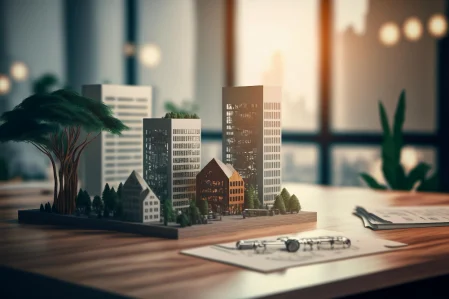
 E-Commerce App Development Services
E-Commerce App Development Services E-Commerce Web Development Services
E-Commerce Web Development Services Blockchain E-commerce Development Company
Blockchain E-commerce Development Company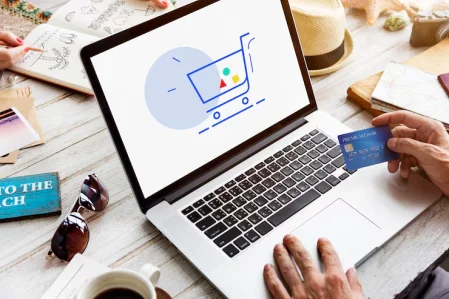
 Fintech App Development Services
Fintech App Development Services Fintech Web Development
Fintech Web Development Blockchain Fintech Development Company
Blockchain Fintech Development Company
 E-Learning App Development Services
E-Learning App Development Services
 Restaurant App Development Company
Restaurant App Development Company
 Mobile Game Development Company
Mobile Game Development Company
 Travel App Development Company
Travel App Development Company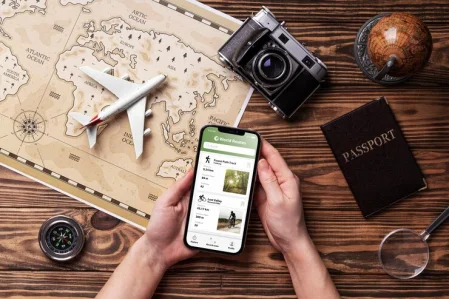
 Automotive Web Design
Automotive Web Design
 AI Traffic Management System
AI Traffic Management System
 AI Inventory Management Software
AI Inventory Management Software
 AI Software Development
AI Software Development  AI Development Company
AI Development Company  AI App Development Services
AI App Development Services  ChatGPT integration services
ChatGPT integration services  AI Integration Services
AI Integration Services  Generative AI Development Services
Generative AI Development Services  Natural Language Processing Company
Natural Language Processing Company Machine Learning Development
Machine Learning Development  Machine learning consulting services
Machine learning consulting services  Blockchain Development
Blockchain Development  Blockchain Software Development
Blockchain Software Development  Smart Contract Development Company
Smart Contract Development Company  NFT Marketplace Development Services
NFT Marketplace Development Services  Asset Tokenization Company
Asset Tokenization Company DeFi Wallet Development Company
DeFi Wallet Development Company Mobile App Development
Mobile App Development  IOS App Development
IOS App Development  Android App Development
Android App Development  Cross-Platform App Development
Cross-Platform App Development  Augmented Reality (AR) App Development
Augmented Reality (AR) App Development  Virtual Reality (VR) App Development
Virtual Reality (VR) App Development  Web App Development
Web App Development  SaaS App Development
SaaS App Development Flutter
Flutter  React Native
React Native  Swift (IOS)
Swift (IOS)  Kotlin (Android)
Kotlin (Android)  Mean Stack Development
Mean Stack Development  AngularJS Development
AngularJS Development  MongoDB Development
MongoDB Development  Nodejs Development
Nodejs Development  Database Development
Database Development Ruby on Rails Development
Ruby on Rails Development Expressjs Development
Expressjs Development  Full Stack Development
Full Stack Development  Web Development Services
Web Development Services  Laravel Development
Laravel Development  LAMP Development
LAMP Development  Custom PHP Development
Custom PHP Development  .Net Development
.Net Development  User Experience Design Services
User Experience Design Services  User Interface Design Services
User Interface Design Services  Automated Testing
Automated Testing  Manual Testing
Manual Testing  Digital Marketing Services
Digital Marketing Services 
 Ride-Sharing And Taxi Services
Ride-Sharing And Taxi Services Food Delivery Services
Food Delivery Services Grocery Delivery Services
Grocery Delivery Services Transportation And Logistics
Transportation And Logistics Car Wash App
Car Wash App Home Services App
Home Services App ERP Development Services
ERP Development Services CMS Development Services
CMS Development Services LMS Development
LMS Development CRM Development
CRM Development DevOps Development Services
DevOps Development Services AI Business Solutions
AI Business Solutions AI Cloud Solutions
AI Cloud Solutions AI Chatbot Development
AI Chatbot Development API Development
API Development Blockchain Product Development
Blockchain Product Development Cryptocurrency Wallet Development
Cryptocurrency Wallet Development About Talentelgia
About Talentelgia  Our Team
Our Team  Our Culture
Our Culture 
 Healthcare App Development Services
Healthcare App Development Services Real Estate Web Development Services
Real Estate Web Development Services E-Commerce App Development Services
E-Commerce App Development Services E-Commerce Web Development Services
E-Commerce Web Development Services Blockchain E-commerce
Development Company
Blockchain E-commerce
Development Company Fintech App Development Services
Fintech App Development Services Finance Web Development
Finance Web Development Blockchain Fintech
Development Company
Blockchain Fintech
Development Company E-Learning App Development Services
E-Learning App Development Services Restaurant App Development Company
Restaurant App Development Company Mobile Game Development Company
Mobile Game Development Company Travel App Development Company
Travel App Development Company Automotive Web Design
Automotive Web Design AI Traffic Management System
AI Traffic Management System AI Inventory Management Software
AI Inventory Management Software AI Software Development
AI Software Development AI Development Company
AI Development Company ChatGPT integration services
ChatGPT integration services AI Integration Services
AI Integration Services Machine Learning Development
Machine Learning Development Machine learning consulting services
Machine learning consulting services Blockchain Development
Blockchain Development Blockchain Software Development
Blockchain Software Development Smart contract development company
Smart contract development company NFT marketplace development services
NFT marketplace development services IOS App Development
IOS App Development Android App Development
Android App Development Cross-Platform App Development
Cross-Platform App Development Augmented Reality (AR) App
Development
Augmented Reality (AR) App
Development Virtual Reality (VR) App Development
Virtual Reality (VR) App Development Web App Development
Web App Development Flutter
Flutter React
Native
React
Native Swift
(IOS)
Swift
(IOS) Kotlin (Android)
Kotlin (Android) MEAN Stack Development
MEAN Stack Development AngularJS Development
AngularJS Development MongoDB Development
MongoDB Development Nodejs Development
Nodejs Development Database development services
Database development services Ruby on Rails Development services
Ruby on Rails Development services Expressjs Development
Expressjs Development Full Stack Development
Full Stack Development Web Development Services
Web Development Services Laravel Development
Laravel Development LAMP
Development
LAMP
Development Custom PHP Development
Custom PHP Development User Experience Design Services
User Experience Design Services User Interface Design Services
User Interface Design Services Automated Testing
Automated Testing Manual
Testing
Manual
Testing About Talentelgia
About Talentelgia Our Team
Our Team Our Culture
Our Culture

















 Write us on:
Write us on:  Business queries:
Business queries:  HR:
HR: 




